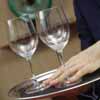The commis sommelier
In many restaurants the wine management - the ordering, stock control, recommendations to customers, training, quality control and, sometimes, service of wine - can be left to the manager or bar staff. When your business reaches the position that either of these roles are compromised by wine-related issues, or that wine sales are not maximised because of other duties, it is time to employ a sommelier.
Managers may not be able to control the service effectively, provide accurate billing and attend to customer requirements if they are taking a large role in serving wines. Similarly, bar staff or waiting staff may be too busy with food or bar work to take full advantage of wine-selling opportunities.
Creating a sommelier position may take the form of assigning a member of floor staff all wine-related tasks, under supervision of the manager. Backing this up with wine training and tastings; encouraging interaction with the chef to create wine pairings; offering a larger and more exciting range of wines by the glass; and active promotion of dessert wines can ultimately lead to increased wine sales and bigger profits.
Ronan Sayburn
It's a long way from wanting to be a geologist to becoming the executive head sommelier for what is probably the most influential restaurant group in London. But that's the journey that 35-year-old Ronan Sayburn has completed over the past 15 years. However, as the Gordon Ramsay group's wine maestro points out, there is a link: it's in the rocks and the soil - the terroir - which so influences the qualities of the grape and, ultimately, the wine.
"Geology, physics, biology, chemistry - there are elements of these in the knowledge of a sommelier. You've got to know how the lay of the land affects the vines, the chemical reactions in the winemaking process," he says.
Sayburn's wine career was kick-started by Gerard Basset, of Hotel du Vin fame, who secured him a job at Le Manoir aux Quat'Saisons. A stint out in the big wide world of wine merchanting followed, before taking on the sommelier's role at London's two-Michelin-starred Pied à Terre. He hooked up with Ramsay nearly six years ago and now oversees the wine operations in the group's eight London restaurants.
Most of the time, Sayburn is based at the group's flagship Gordon Ramsay restaurant in Royal Hospital Road - it's open five days a week and he's there front-of-house on four out of the five - but his remit also includes putting together the sommelier teams at the restaurants and overseeing wine training.
His is a demanding job, but Sayburn is evangelistic about raising the profile of the sommelier's trade outside his own realm, managing to make time to sit on the wine committee of the Academy of Food & Wine Service and to give lectures and seminars on his subject at colleges and trade shows on a regular basis.
"One of the reasons why I wanted to do these masterclasses with Caterer was because we don't have an awful lot of home-grown sommeliers in UK restaurants. There are some really good British sommeliers coming through now, but we need more, and I wanted to show everybody that you don't have to start with a massive knowledge if you want to make a career as one. You can learn. Enthusiasm, a hard-working attitude and an open mind are more important when you are starting out."
The role of the commis sommelier
A large restaurant operation might require a team of sommeliers operating a hierarchy similar to a kitchen brigade. At the junior end of this team is the commis sommelier.
They are classed as a trainee sommelier and are maybe a junior waiter who shows particular interest in wines or an enthusiastic sommelier whose knowledge is not yet up to the level required by the company. Their role is to provide support to sommeliers and head sommeliers in the form of mise en place, cellar work, cleaning and care of glassware and, during service time, serving water, clearing and replacing glassware, serving aperitifs, digestifs and wine when required, and maintaining clean work stations and back-of-house areas.
Also, during service, commis are required to assist other restaurant staff - changing ashtrays, if appropriate, pulling out chairs for customers, directing customers to the bathroom, folding napkins neatly when customers leave the table, and helping to clear tables when customers leave.
Appearance and behaviour The standard uniform is black shoes, socks, short hair, no rings, clean white shirt, wing collar or plain, no visible buttons or button-down collars.
A traditional sommelier's uniform would be black apron and jacket. Gold grape badges may be worn by head sommeliers, silver by sommeliers. No badges are worn by commis.
The commis should have a good waiter's friend with them and a clean service cloth.
Obviously, a love of wine is required and a respect for what you are serving and whom you are serving. Minor mistakes are often forgiven by customers if they see that you are friendly, enthusiastic and passionate about what you do.
Honesty is paramount. Often a little knowledge can go straight to one's head, and it is a bad habit to acquire. If unsure, politely admit to not knowing the answer to certain questions and redirect to a more senior sommelier or manager - do not lie or make up answers to customers.
Glassware The best type of glasses for wine service are completely plain, uncoloured and unengraved, with a long stem and large bowl.
Polishing Always polish glasses with a dry cloth when hot; damp cloths polishing cold glasses will cause the stems to break. Polish with clean, lint-free linen cloths.
Always check glasses against the light to make sure they are clean - free of lipstick or stubborn marks such as tomato juice - and not chipped or damaged in any way. Clean all glasses in a neat and regimented manner: all water glasses together, then all wine glasses. Being well organised reduces breakages and speeds up the process of polishing.
Carrying glasses Never carry glasses by hand in the restaurant. Always use a clean, slip-proof silver salver with one hand underneath the tray and the other on top securing the foot of the glasses.
Mise en place Glasses should be given one final polish before being put on tables to avoid dust that may have accumulated overnight or during storage. Check against the light for chips or glasswasher "burn" marks (milky colour). Table set-up might differ slightly in each restaurant but will often be one water glass and one white wine glass placed exactly the same on each cover, orientated to the cover plate and symmetrical to the glasses on the opposite side of the table.
Station and work areas/trolleys These should be checked and replenished with glasses, and any glasses left in these areas from the previous service should be checked for dust.
When not in use, glasses should be stored upright in dust- and grease-free areas on clean shelving.
Water service Always check the water is sufficiently chilled to serve. There should be condensation on the outside of the bottle, which indicates that the water temperature is less than 8°C. Always take two bottles automatically for a table of four or more - one 75cl bottle will serve four glasses. Make sure that the water is charged to the table. Develop a system to double-check this. Many restaurants lose money when staff are busy and forget these basics.
Pour water for the women first - gently and slowly without causing splashes. Do not fill the glasses more than half-full.
After the water has been offered and poured the labels should be clearly marked, in the top left hand corner, with the table number and position of those drinking it. For example, 4/2,3,5 would mean on table 4, positions 2, 3 and 5 are drinking water from that bottle. In the early stages of the meal water should be replaced automatically. In the later stages ask politely if the customers would like another bottle.
All water fridges should be stocked at least 45 minutes before each service to allow water to be chilled thoroughly.
Ice buckets The ice buckets and ice bucket stands should be well cleaned at least once a week by a kitchen porter - supervised by a commis sommelier.
Before customers arrive, the ice buckets should be in place - filled two-thirds full of ice and one-third of water - with a clean, neatly folded napkin placed across the top and tucked into the sides of the stand.
During service do not take the cloths away from the buckets. These are for the waiters to serve with; sommeliers should have their own cloths.
After service the ice buckets should be emptied and rinsed with warm water before drying with a clean cloth.
Pouring from bottles Always pour for women first, except if she is the host. Always pour anticlockwise from the host, and serve the host last, even when it is a woman. Always pour slowly and gently without splashing. Have a service cloth at hand to catch any drips.
Certain rules can be broken depending on the situation. Common sense and good manners are the main guides. If you have to disturb a conversation, or lean across, or serve from the left due to table location, then do so politely.
Cellar work/back of house Carry bottles of red wine from the cellar to the restaurant gently with the label facing upwards - bottles are always stored like this. If there is a deposit in the wine, you will know that it lies directly under the label.
Cellar work can be done in casual clothes. Old aprons should be worn when handling dirty wine cases. Wine cases should be carefully broken down and disposed of properly. Wines must be stacked safely to avoid breakages.
Cellars should be kept clean and tidy to comply with fire regulations and health and safety laws.
Digestif trolley Cleaning of trolleys (digestif and Champagne) are commis duties, as is supervising regular cleaning and maintenance of decanters and silver - stands, ice buckets, coasters, bottle holders and salvers.













